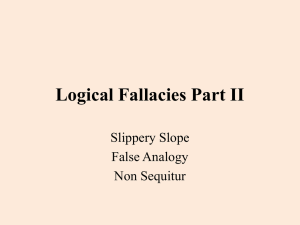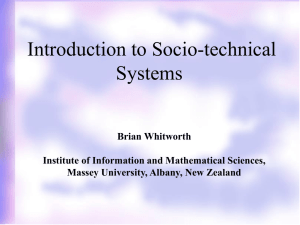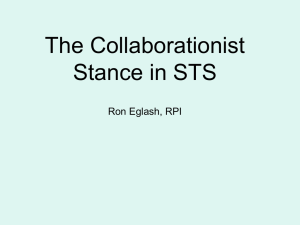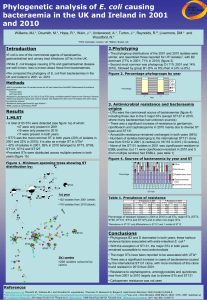Ethics of Teamwork
advertisement
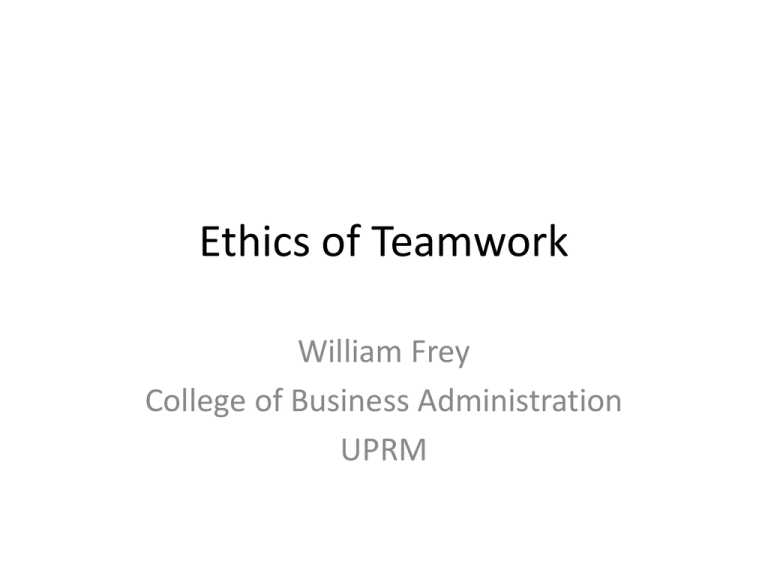
Ethics of Teamwork William Frey College of Business Administration UPRM Overall Task in Module • Realize Values through… – Discovery • discover’ the values that are relevant to, inspire, or inform a given design project – Translation • embodying or expressing…values in system design. Translation is further divided into operationalization, which involves defining or articulating values in concrete terms, and implementation which involves specifying corresponding design features – Verification • designers assess to what extent they have implemented target values in a given system…. [M]ay include internal testing among the design team, user testing in controlled environments, formal and informal interviews and surveys, the use of prototypes, traditional quality assurance measures such as automated and regression-oriented testing, and more • In Software Engineering… –“‘discover’ the values that are relevant to, inspire, or inform a given design project” (Flanagan et. al., 334) • Ethics of Teamwork –discover values that help define your group • Constructing a socio-technical table (Exercise 2a) • Setting value goals in Preliminary selfevaluation • In software engineering… – “embodying or expressing…values in system design. Translation is further divided into operationalization, which involves defining or articulating values in concrete terms, and implementation which involves specifying corresponding design features.” (Flanagan et. al., 339) • In group work… – Values are operationalized by developing value profiles in Preliminary Self-Evaluation • Using SOV to broadly characterize group’s values • Developing procedures (how you divide group work) to realize values – Values are implemented by using procedures in class to carry out group assignments and reporting on these in midsemester audit • Preparing assignments and recording what your group’s procedures are and how well they work • Identifying challenges and recording how your group responded • In software engineering… – “designers assess to what extent they have implemented target values in a given system…. [M]ay include internal testing among the design team, user testing in controlled environments, formal and informal interviews and surveys, the use of prototypes, traditional quality assurance measures such as automated and regression-oriented testing, and more.” (Flanagan et. al., 344-5) • In Ethics of Teamwork you will validate your values in your final group self-evaluation – Repeat the values and strategies you developed in the Preliminary self-evaluation – Describe the procedures your group used to realize values and document how well they worked – Identify challenges faced by group, responses, and how well the responses worked – What were the lessons you and your group learned through your work this semester Pitfalls of group work • Groupthink – Your group fails to process and respond to critical information. (Setting up filters to “delete” critical information) • Polarization – Differences between group members harden into opposition that paralyzes group deliberation and action • Going to Abilene – Group reaches a consensus—each member gives way to the consensus because they think the other members want it. But the consensus is embraced by nobody. Group deliberation and action breaks down because of a failure in communication. Some more pitfalls and problems • Free Riders – A group member benefits from the work done by others but fails to contribute. He or she rides along for free • Outliers – A group member tries to participate but fails to penetrate the clicks that exist within a group • Hidden Agendas – A group member withholds his or her views and solutions because they seem to be “at odd” with the majority view of the group • Conflict of Effort – Each group member is over-committed. Group never has time to work together because of conflicting schedules and winds up producing fragmented work (Each individually does something which is never integrated with the work of others) Exercise 2 • Develop strategies to avoid group pitfalls • Strategies from Module – – – – – – negotiate interests instead of positions expand the pie nonspecific compensation logrolling cost-cutting bridging • See also strategies from Irving Janis on avoiding groupthink – devil’s advocate – outside respondent – techniques for avoiding “hidden agendas” • These, in general, realize the value of reasonableness (See module) Design roles to realize values and avoid pitfalls • Leader – • Spokesperson – • This person criticizes the group’s consensus. This should be a rotating position so that no individual gets labeled as a trouble-maker. Mediator – • This person participates but also records and documents the group’s procedures. How did the group prepare its first assignment? What challenges did the group face? How did it respond and how successful was this repsonse? Devil’s Advocate – • Have somebody outside of group respond to procedures, practices, and habits. Listen, don’t defend. Recorder – • This individual communicates group concerns, interests, and contributions to the teacher and the rest of the class Independent outside observer – • There are different kinds of leader. Rotate this role and experiment with these This individual is especially adept at empathy, compassion, and role taking. Bridges the gap between differing individual and prevents difference from hardening into opposition Sub-Groups – If the group has a difficult reaching a consensus, divide into sub-groups charged with exploring the differing points of view. At the very least, this guarantees a voice for dissenting views. Value Profiles • Value: “a claim about what is worthwhile. [A] single word or phrase that identifies something as being desirable.” • Reasonableness: Resolving differences and disagreements with civility and respect. Avoids extremes of giving in and holding on. Openness to arguments of others and willingness to validate one’s own arguments • Responsibility: To stand committed to carrying out the tasks associated with one’s social and professional role. (Being a good leader, devil’s advocate, recorder….Seeing through on one’s commitments) • Respect: To treat each individual (including oneself) always as an end and never merely as a means to an end. • Trust: According to Solomon, it is the expectation of moral conduct from others, especially one’s group members • Brincat and Wike, Morality and the Professional Life: Values at Work Value Profiles • Justice: Giving to each his or her due. A just or fair distribution of work and responsibility integrates equality, need, and merit. You and your group need to think carefully about how you will distribute the benefits and burdens of group work • Honesty: disclosing the truth while avoiding the extremes of brutal indifference (making the truth hurt) and dishonesty (deception or withholding of vital information) • Integrity: This meta-value sheds light on the overall coherence of the other values as they are expressed in character and action. The opposite of integrity is corruption where there is a breakdown at an individual or organizational level or both. – See Robert Bolt’s play, “A Man For All Seasons” What you will do now • Preliminary Self-Evaluation • Exercises 1, 2, and 2a in Ethics of Team Work Module • Identify value goals, profile these, and describe procedures to realize them • Identify strategies your group will use to avoid group pitfalls and problems • Develop, briefly, a STS table to describe the different interacting environments in which you will be working Socio Technical Systems Socio-Technical systems provide a tool to uncover the different environments in which business activity takes place and to articulate how these constrain and enable different business practices. A STS can be divided into different components such as hardware, software, physical surroundings, stakeholders, procedures, laws, and information systems. But while different components can be distinguished these are, in the final analysis, inseparable. STSs are, first and foremost, systems composed of interrelated and interacting parts. STSs also embody values such as moral values (justice, responsibility, respect, trust, and integrity) and non-moral values (efficiency, satisfaction, productivity, effectiveness, and profitability). Often these values can be located in one or more of the system components. Often these values conflict with one another causing the system to change. STSs change and this change traces out a path or trajectory. The normative challenge of STS analysis is to find the trajectory of STS change and work to make it as value positive and value realizing as possible. Example of STS Table Technology Software Physical Surroundings Stakeholders Procedures Laws (university regulations Information systems Classroom Computers Microsoft Office (Social Networking Media) Describe classroom and show how constrains interaction Teacher, your group members, you, other teachers, other classmates Give one of your procedures for value realization Rules on research misconduct How your group assembles information scattered throughout group Timeline • Today: Orientation to module and division of class into work groups • Next Class: Classroom laboratory time for groups to work on module • Next Class: Preliminary selfevaluations due. (One from each group)



